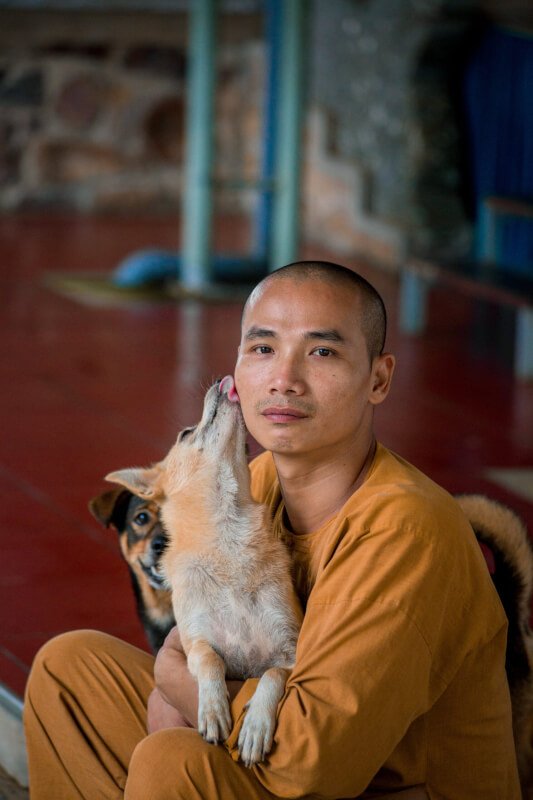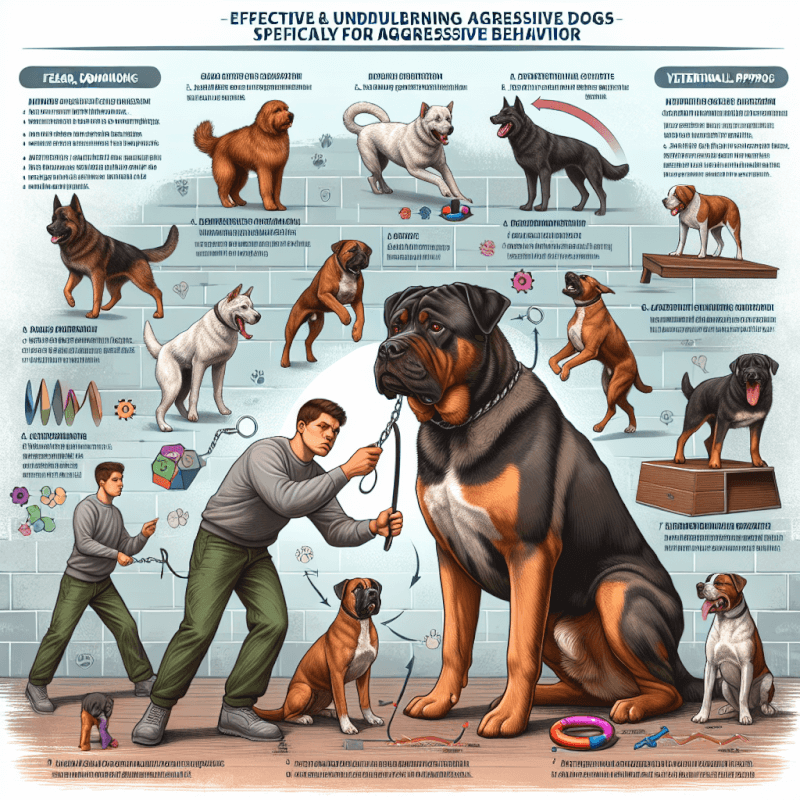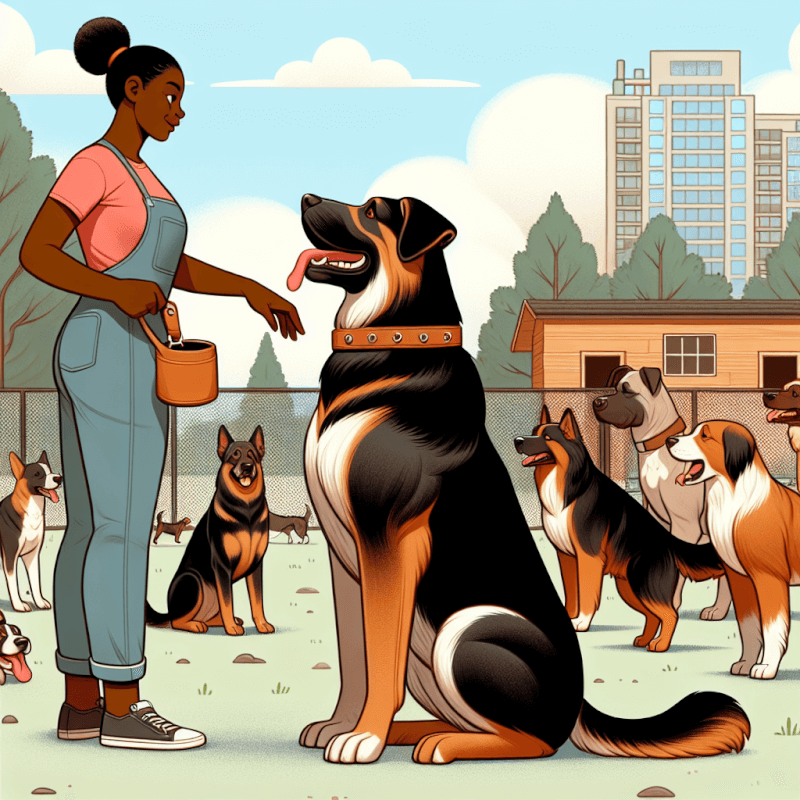Are you struggling with an aggressive dog? If so, you’re not alone! Dealing with aggression in pets can be a daunting and stressful experience. However, there is hope. In this article, we will explore effective pet training techniques specifically designed for aggressive dogs. By following these expert tips and tricks, you will learn how to navigate the challenges and nurture a happier and more well-behaved furry friend. So, let’s dive into the world of pet training for aggressive dogs and discover a path towards a harmonious relationship between you and your beloved companion.
Understanding Aggression in Dogs
Aggression in dogs can be a concerning issue for many pet owners. It is important to understand the different types of aggression, the causes behind it, and how to recognize aggressive behavior. By gaining this knowledge, you will be better equipped to address and manage your dog’s aggression effectively.

Ready for Cat Trivia?
Test your knowledge about cats!

Types of Aggression
Dogs can display various forms of aggression, each with its own distinct characteristics. Understanding these types of aggression is crucial in determining the appropriate intervention strategies. Here are some common types of aggression in dogs:
Territorial Aggression: This occurs when a dog perceives a threat to its territory or personal space. It may manifest as barking, growling, and even biting.
Fear Aggression: Dogs that are fearful may become aggressive as a defensive mechanism. Their aggression is triggered by a perceived threat or stressful situation.
Protective Aggression: Dogs may display protective aggression when they feel the need to defend themselves, their owners, or their resources. This aggression is often directed towards strangers or other animals.
Social Aggression: This type of aggression is seen during conflicts between dogs and generally involves establishing dominance or competing for resources.
Predatory Aggression: Dogs with a strong prey drive may exhibit predatory aggression towards small animals or even people. They may give chase and attack without warning.
Understanding the specific type of aggression your dog exhibits is essential for developing an effective training and management plan.
Causes of Aggression
There are several factors that can contribute to a dog’s aggressive behavior. Identifying these underlying causes is crucial in addressing the aggression effectively. Here are some potential causes of aggression in dogs:
Lack of Socialization: Dogs that have not been properly exposed to various stimuli during their critical socialization period may develop fear or aggression towards unfamiliar people, animals, or situations.
Genetic Factors: Certain breeds may have a predisposition towards aggression due to their genetic makeup. However, it is important to note that genetics alone do not determine a dog’s behavior, as upbringing and environment also play a significant role.
Fear and Anxiety: Dogs that experience chronic fear or anxiety may lash out aggressively as a coping mechanism. Identifying and addressing the fear or anxiety triggers can help alleviate their aggressive behavior.
Medical Issues: Some medical conditions or pain can cause a dog to exhibit aggressive behavior. It is essential to rule out any underlying medical issues by consulting with a veterinarian.
Previous Traumatic Experiences: Dogs that have experienced abuse, neglect, or trauma in the past may develop aggression as a result. These dogs may require specialized care and rehabilitation techniques.
By understanding the root causes of your dog’s aggression, you will be better equipped to address them and implement the appropriate training and management strategies.
Recognizing Aggressive Behavior
Being able to recognize the signs of aggressive behavior is essential for early intervention and prevention. Dogs often display subtle cues before escalating into aggressive behavior. By observing and understanding these cues, you can take necessary steps to prevent potential aggression. Here are some common signs of aggression in dogs:
Body Language: Dogs may display stiff body posture, raised hackles, pinned-back ears, and a tense facial expression when feeling aggressive.
Growling and Snarling: These vocalizations indicate that a dog is feeling threatened or uncomfortable. It is a warning sign that should not be ignored.
Biting: Aggressive dogs often resort to biting as a means of protecting themselves or expressing their aggression. It is essential to address aggression before it progresses to this point.
Resource Guarding: Dogs may exhibit aggression when they perceive a threat to their valued resources, such as food, toys, or territory.
By being vigilant and recognizing these signs of aggression, you can take proactive measures to manage and mitigate potentially dangerous situations.
Seeking Professional Help
While addressing aggression in dogs is possible through independent efforts, seeking professional guidance is highly recommended. A qualified dog trainer or behaviorist can provide invaluable insight, expertise, and support throughout the training process. Here’s why professional help is so important:
Importance of Professional Guidance
Trained professionals have the expertise and experience necessary to assess your dog’s aggression accurately and develop a personalized training plan. They can help you identify the underlying causes, determine the most effective training techniques, and monitor progress over time. Additionally, they can provide guidance and support for you as a pet owner, answering any questions or concerns you may have along the way.
Choosing a Qualified Dog Trainer or Behaviorist
When selecting a professional to help with your aggressive dog, it is essential to consider their qualifications and approach to training. Look for a trainer or behaviorist who specializes in aggression and has a positive reinforcement-based training philosophy. They should have relevant certifications, a solid track record, and a good reputation within the dog training community. Take the time to research and find someone who aligns with your goals and values as a pet owner.
By seeking professional help, you can enhance your understanding of your dog’s aggression, learn effective training techniques, and receive the support needed for a successful resolution.
Creating a Safe Environment
Creating a safe environment for your aggressive dog is crucial for both their well-being and the safety of others. By taking certain precautions and implementing management strategies, you can minimize the risk of aggressive incidents. Here are some key aspects to consider:
Securing Your Home
Ensuring a secure home environment is essential to prevent your dog from escaping, getting into trouble, or posing a threat to others. Take the following steps to secure your home:
Secure Fencing: Install sturdy fencing around your property, ensuring that it is tall enough to prevent your dog from jumping over or digging under.
Gates and Locks: Use secure gates and locks to limit access to specific areas, such as your front yard or backyard.
Escape Prevention: Identify any potential escape routes and take measures to block them off, such as reinforcing fences or adding additional barriers.
By securing your home, you can create a safe space for your dog where they can feel secure and reduce the risk of them exhibiting aggression towards strangers or other animals.

Limiting Exposure to Triggers
Identifying and managing your dog’s triggers is crucial for preventing or minimizing aggressive behavior. Exposure to certain stimuli can provoke fear or anxiety, leading to aggression. Here’s how you can limit their exposure to triggers:
Avoidance: If you know certain situations or stimuli trigger your dog’s aggression, try to avoid or minimize their exposure to these triggers whenever possible.
Controlled Socialization: Gradually expose your dog to new people, animals, and environments in a controlled manner, ensuring positive experiences and avoiding overwhelming situations.
Structured Walks: Take your dog on structured walks, using leashes and muzzles if necessary, to maintain control and prevent confrontations with other dogs or individuals.
By creating a safe environment and managing your dog’s exposure to triggers, you can reduce the likelihood of aggression and create a more harmonious living environment for everyone involved.
Positive Reinforcement Training
Positive reinforcement training is a highly effective and humane approach to address aggressive behavior in dogs. By rewarding desired behaviors, you can encourage your dog to make positive associations and learn alternative, non-aggressive responses. Here are some key techniques used in positive reinforcement training:
Reward-Based Training Techniques
Positive reinforcement training involves rewarding your dog for exhibiting appropriate behavior. This can be done through treats, praise, or play. By rewarding desired behaviors, such as calmness or obedience, your dog will learn which behaviors are favorable and will be motivated to repeat them.
Clicker Training
Clicker training is a popular method used in positive reinforcement training. It involves using a clicker, a small handheld device that makes a distinctive sound when pressed, to mark the desired behavior. The click is then immediately followed by a reward, creating a strong association between the behavior and the reward.

Marker Training
Similar to clicker training, marker training involves using a verbal cue, such as the word “yes” or a distinctive sound, to mark the desired behavior. The marker is followed by a reward, reinforcing the behavior. Marker training can be a convenient alternative to clicker training in situations where a clicker is not practical to use.
By utilizing positive reinforcement training techniques, you can replace aggressive behaviors with more appropriate and desirable actions, leading to a well-behaved and confident dog.
Socialization and Desensitization
Socialization and desensitization play significant roles in addressing aggression and building a well-rounded dog. By carefully introducing your dog to new stimuli and gradually exposing them to various situations, you can help them overcome their fears and develop positive associations. Here’s how to approach socialization and desensitization:
Introducing Dogs to New Stimuli
Expose your dog to various stimuli, such as unfamiliar people, other dogs, different environments, and novel sounds, in a controlled and positive manner. Start with low-level exposure and gradually increase the intensity as your dog becomes more comfortable.
Gradual Exposure and Counterconditioning
Gradual exposure involves exposing your dog to their triggers in a systematic and controlled way. This allows them to build up their tolerance and develop positive associations. Counterconditioning involves pairing the presence of a trigger with something positive, such as treats or play, to create a positive emotional response.
By socializing and desensitizing your dog, you can expand their comfort zone, reduce their anxiety, and minimize their tendency to display aggressive behavior in unfamiliar or stressful situations.
Teaching Basic Obedience Commands
Teaching your dog basic obedience commands is essential for establishing control and preventing aggressive situations. By teaching them commands such as sit, stay, leave it, drop it, and recall, you can effectively communicate and redirect their behavior when needed. Here’s a breakdown of these commands:

Sit
Teaching your dog to sit on command is the foundation for many other obedience exercises. Start by holding a treat close to your dog’s nose, then slowly move it upward. As their head follows the treat, their lower body should naturally lower into a sitting position. Once they are sitting, give the command “sit” and reward them with the treat.
Stay
The “stay” command teaches your dog to remain in a specific position until given the release command. Start by having your dog sit or lie down, then extend your hand in front of them and say “stay.” Step backward slowly, maintaining eye contact with your dog. If they remain in place, reward them and release them with a release command. Gradually increase the duration and distance of the stay.
Leave It
The “leave it” command teaches your dog to ignore or let go of something they desire. Start by presenting a treat in your closed hand and saying “leave it.” The moment your dog stops trying to get the treat, reward them with a different treat from your other hand. Repeat this exercise, gradually increasing the difficulty by using more tempting items.

Drop It
The “drop it” command teaches your dog to release an item from their mouth. Start by offering a toy or object your dog enjoys having in their mouth. Once they pick it up, present them with a treat and say “drop it.” When they release the object, reward them with the treat. Repeat this exercise, gradually fading the treat rewards.
Recall
Recall, or the “come” command, is crucial for ensuring your dog returns to you when called. Start by calling your dog’s name followed by the command “come” in an enthusiastic tone. As they approach you, reward them with praise and treats. Gradually increase the distance and distractions while practicing the recall command.
By teaching your dog these basic obedience commands, you establish a foundation of communication and control that can help prevent potential aggression and ensure their safety.
Implementing Management Strategies
In addition to training, implementing management strategies is necessary to prevent potential aggressive incidents and maintain optimal safety for both your dog and others. Here are two essential management strategies:
Using Leashes and Muzzles
Using a leash is crucial for maintaining control and preventing your dog from approaching potential triggers. A leash provides physical restraint while allowing you to redirect your dog’s attention and manage their behavior.
In some cases, using a muzzle may be necessary, especially if your dog has a history of aggression towards people or other animals. A properly fitted muzzle ensures that there is no risk of biting, providing an extra layer of safety.
Crate Training
Crate training can be highly beneficial for managing aggressive behavior while keeping your dog safe and secure. A crate serves as a den-like space where your dog can feel comfortable and have their own designated area. It is particularly useful when you need to separate your dog from potential triggers or during times when you cannot actively supervise them.
When introducing crate training, make it a positive experience by using treats, toys, and calming cues. Gradually increase the time your dog spends in the crate, ensuring it remains a safe and comfortable space.
Implementing these management strategies can assist in preventing potential aggression and ensuring the safety of everyone involved.
Understanding Body Language and Communication
Being able to interpret your dog’s body language and signals is crucial for effective communication and prevention of aggressive incidents. Dogs use various visual cues to communicate their emotions and intentions. By understanding these cues, you can respond appropriately to your dog’s needs and emotions. Here are some common expressions and signals to look out for:
Interpreting Dog’s Expressions and Signals
Ears: Erect ears indicate attentiveness, while pinned-back ears may indicate fear or submission.
Tail: A wagging tail doesn’t always mean a dog is friendly. It is important to observe the context, speed, and height of the wag to determine if it signifies happiness, fear, or aggression.
Eyes: Direct eye contact, dilated pupils, or intense staring can be signs of aggression or a challenge. Soft, relaxed eyes indicate calmness and trust.
Body Posture: A stiff, rigid body posture with raised hackles suggests a dog is feeling defensive or aggressive. A relaxed, loose body posture indicates calmness and a lack of threat.
Lip Licking and Yawning: In stressful situations, dogs may exhibit lip licking or yawning as a way of reducing tension. These behaviors can signal discomfort or anxiety.
By closely observing your dog’s body language, you can better understand their emotions and respond appropriately, preventing potential aggression and promoting effective communication.
Avoiding Triggers and Preventing Escalation
Identifying triggers and minimizing your dog’s exposure to them is key in managing aggression and preventing escalation. By proactively avoiding situations that may provoke aggression, you can create a safer and more harmonious environment for everyone involved. Here’s how to address triggers effectively:
Identifying Triggers
Carefully observe your dog’s behavior and identify the specific situations, stimuli, or individuals that trigger their aggression. Common triggers may include unfamiliar people, other animals, specific noises, or certain environments. Make a note of these triggers to develop a proactive plan.
Removing or Minimizing Exposure to Triggers
Once you have identified the triggers, take steps to remove or minimize your dog’s exposure to them. This may involve avoiding certain areas, socializing them in controlled environments, or limiting interactions with specific individuals or animals. Gradually expose your dog to the triggers at a manageable intensity, using desensitization techniques to help them build positive associations.
Redirecting Attention
When you anticipate a trigger or notice early signs of aggression, redirect your dog’s attention to an alternative behavior or command. This can be achieved by offering a treat, engaging them in a game, or asking them to perform a known command. Redirecting their focus can help diffuse their aggression and prevent an escalation.
By avoiding triggers, minimizing exposure when necessary, and redirecting your dog’s attention, you can effectively manage their aggression and create a safer environment for all.
Consistency and Patience
Consistency and patience are essential when addressing aggression in dogs. Changing behavior takes time and commitment, but the rewards are worth the effort. Here’s why consistency and patience are crucial:
Establishing a Routine
Creating a consistent routine is important for maintaining structure and predictability in your dog’s life. Consistency in training exercises, feeding schedules, and daily activities enables your dog to feel secure and understand what is expected of them. This can help reduce anxiety and prevent aggressive reactions.
Managing Expectations
Rehabilitating an aggressive dog requires patience and realistic expectations. Progress may be gradual, and setbacks can occur. It is important to remain patient, understanding that behavior change takes time.
Ensure that your training goals are achievable and set realistic expectations for your dog. Celebrate small victories and remember that each step forward, no matter how small, is progress.
By maintaining consistency in your approach and exercising patience, you can successfully address your dog’s aggression and provide them with a stable and nurturing environment.
In conclusion, understanding aggression in dogs is an essential step towards addressing and managing this challenging behavior. By recognizing the types of aggression, identifying the causes, and implementing training and management strategies, you can improve your dog’s behavior and create a safer living environment for everyone involved. Seek professional guidance, create a safe environment, practice positive reinforcement training, socialize and desensitize your dog, teach basic obedience commands, implement management strategies, interpret body language, avoid triggers, and remain consistent and patient throughout the process. With dedication and the right approach, you can help your aggressive dog lead a happier and more peaceful life.


